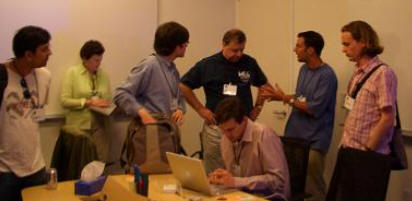|
News & Views item - July 2012 |
![]() Where Are All the Science Jobs? (July 12, 2012)
Where Are All the Science Jobs? (July 12, 2012)
Brian Vastag is a science reporter for The Washington Post. He heads
his July 8, 2012
feature piece "U.S. pushes for more scientists, but the
jobs arenít there", and opens with the simple statement: "There are too many
laboratory scientists for too few jobs", although he agrees that "jobs in some
high-tech areas, especially computer and petroleum engineering, seem to be
booming, [but] the market is much tighter for lab-bound scientists."
Mr Vastag points to a 2009 National Science Foundation (NSF) Servey which found that "only 14 percent of those with a PhD in biology and the life sciences now land a coveted academic position within five years [because] [t]he supply of scientists has grown far faster than the number of academic positions". In addition for a number of reason the availability of positions with Pharmas has declined precipitously in the United States. "Since 2000, U.S. drug firms have slashed 300,000 jobs according to an analysis by consulting firm Challenger, Gray & Christmas. In the latest closure, Roche last month announced it is... shedding another 1,000 research jobs."
And the American Chemical Society has released a survey showing that in 2011 only 38% of new PhD chemists had employment. But Michael S. Teitelbaum, a senior adviser to the Alfred P. Sloan Foundation adds that while "[t]heyíll be employed in something they go and do other things because they canít find the position they spent their 20s preparing for."
On the other hand physicists and physicians show unemployment rates of 1 to 2 percent. Physicists have a breath of fields they can enter, for example Wall Street still wants them and the increasing population supports the medical profession. However, a critical factor in biomedical academia is that "[s]ince 2004, federal research spending across all agencies has stagnated relative to inflation, according to an analysis by the American Association for the Advancement of Science.
Last month TFW reported on the assessment by a working group of the Advisory Committee to the Director of the US National Institutes of Health (NIH) on its assessment of the "Biomedical Workforce" led by Princeton President Shirley Tilghman. It noted the overabundance in biomedical research trainees for academic posts. The Tilghman report not only seeks increases in pay and benefits for post-docs it wants major changes in how NIH funds young scientists thereby diminishing the sectors reliance on postdoc labour.
The working group is aware that similar recommendations have been made in the past by other groups that studied the biomedical research workforce. Many of those recommendations were not implemented, in part because of funding constraints and in part because of resistance from the scientific community. Therefore, the working group urges NIH to provide the funds necessary to implement these recommendations and encourages institutions to work with NIH on the implementation.
As if in response Science reports: "NIH Director Francis Collins said he would like to see some 'experiments' before making 'more systemically disruptive' changes to the funding system'. But, he added, this time the Tilghman panel's recommendations 'will go somewhere. I promise you that.'"